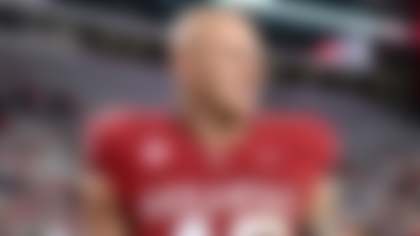Before Super Bowl 50 writes the next chapter in the history of football in the Bay Area, NFL Media is examining local football heroes who were, in their own, unique ways, ahead of their time. Here's the story of a coach whose thoughts helped form today's game ...
Shortly before he died, Bill Walsh called Al Davis and told one of his earliest mentors he wanted to watch a football practice. It was clear to all that what Walsh really wanted was to see one last practice. And so Davis, who gave Walsh his first job in professional football when he hired him as an assistant for the AFL's Oakland Raiders in 1966, invited Walsh to a day at the Raiders' June minicamp in Alameda, California. There, Davis and Walsh, who had grown close late in their lives, watched practice from a golf cart -- two of the most influential men in football history taking in the game they had both so dramatically shaped.
That was eight and a half years ago, but Walsh's fingerprints remain indelibly on the game he conquered in San Francisco. Nearly every team uses at least threads of Walsh's West Coast offense, but his impact on football stretches far beyond the playbook, from how teams practice to how a roster is constructed to, incredibly, what to look for when hiring administrative assistants. One of Walsh's books, "Finding the Winning Edge", is still considered by today's coaches and executives to be a usable, detailed how-to manual for leading a football organization.
"He was a true -- and the word makes me cringe because it is so overused -- but he truly was an innovator," Hall of Fame general manager Bill Polian said. "He thought about the game in a different way than everybody else."
Here are 50 lessons from Bill Walsh, gathered via conversations with coaches, players and executives who continue to spread Walsh's influence:
1) David Shaw (Stanford coach, who played for Walsh at Stanford): One of the most important things I learned being around Coach Walsh was that nothing happened because of luck. He planned for every situation and every eventuality. We had an answer for every blitz, every coverage and game situation, because we were challenged to prepare.
2) Matt Hasselbeck (NFL quarterback, who played for former Walsh assistant Mike Holmgren in Green Bay and Seattle): In scouting an opponent, we never really cared too much about the opponent. My friends on other teams would have detailed reports of the defense. Bill Walsh's mentality was, "We're going to worry more about us and less about them." That mindset: Just do things right, and the score will take care of itself.
3) Tony Dungy (Former NFL head coach, who played for Walsh's 1979 Niners team): Bill's thought process was, "I'm going to take advantage of what you do well." He was doing a lot of substituting, getting certain matchups. It was fascinating.
4) Amy Trask (Former Oakland Raiders CEO): Every conversation I had with Bill reinforced two things: One, intelligence matters. Every instance where Al [Davis] and Bill were having terrific exchanges about Xs and Os, I was thinking, I'm listening to these two incredibly intelligent football men, finding ways that work for them. The other was, this was a man who was superb at playing the game of three-dimensional chess that I viewed football as being. The detail, his detailed observations and detailed strategies supported that notion.
5) David Shaw: The way we begin games with a "First 15." I firmly believe that this was in line with Bill's love of boxing. This is the idea of starting games by probing your opponent with a variety of plays like a boxer would "stick and move."
6) Ernie Accorsi (Former GM of the New York Giants, Cleveland Browns and Baltimore Colts): He would lock himself in a room on Monday night, turn on classical music, and he would create plays. Like a great composer. Alone. And design all the plays.
7) David Shaw: That conversation [with Walsh about what he looked for in a quarterback] is still my basis for evaluating QBs. I have to see the QB have a "feel" for moving in the pocket; he must have great anticipation for throwing the ball and be at his best in critical situations when the game is on the line.
8) Steve Young (Former 49ers quarterback, who played for Walsh in 1987 and '88): I was mad at Bill most of the time. He was a complex personality. I saw the method to the madness, [but] sometimes it offended me. Just because you understand me, you can't manipulate me. When he brought me in, he made it chaotic -- he loved creative tension. The [beneficiary] of it is [the] team, but the individuals -- it's tense. He created it. He didn't make life easy on anybody.
9) Matt Hasselbeck: One thing Mike Holmgren always used to say, he would say it while yelling at me, and I didn't understand it at first, was, "You're a quarterback -- an artist, not a blacksmith." ... When I really evaluated myself, I knew the defense, I knew the coverage, I knew where the ball was supposed to go. I would see Brett Favre, and they'd be in an under front, and he would not throw the hot, he would go to the curl. You're not supposed to do that. The Bill Walsh mindset of, "You're an artist, not a blacksmith; you paint your canvas throughout the game."
10) Ernie Accorsi: The thing about Walsh that was totally misunderstood was he had a two-back offense, Montana under center, a tight end. When you see a lot of these "basketball on turf" offenses, their defenses are never physical. When you practice against that all the time, your defense becomes a finesse defense, because you don't practice against the run. They give him credit for the passing game, but he ran the ball and he always had tough, physical teams.
11) Bill Polian (Former GM of the Indianapolis Colts, Carolina Panthers and Buffalo Bills): We started talking about what people today call "system fit" -- how you fit players into a specific offensive and defensive system. He was the first coach I'd come across who had a really firm idea, right down to the last detail, about how he wanted to structure the squad -- skill set, size.
12) Brian Billick (Former Baltimore Ravens head coach and co-author of Walsh's book, "Finding the Winning Edge"): Position-specific skills. ... [Bill] Belichick has taken it to a whole other level. Maybe this guy isn't the best athlete or player, but he's the player that shows specific skills that we want to use him for.
13) Bill Belichick (New England Patriots head coach): I thought ["Finding the Winning Edge"] was presented in a very well thought-out and orderly manner. I had never seen anything like that, that was so comprehensive about running/setting up an organization.
14) Tony Dungy: You don't have to go along with the crowd -- it's, "Who can play for us and what things do we need?" Know what we need. We'll evaluate very specific to that, not what the rest of the league feels. Joe Montana might not have all the attributes everybody was looking for -- I guess that was innovative, too, I heard that same thing from Coach [Chuck] Noll.
15) Brian Billick: Bill Walsh was very specific on the offensive side, the skills he felt each position needed to have, the left guard versus the right guard, a slot receiver -- Bill didn't want all the same receivers.
16) Ernie Accorsi: I asked him how he found Dwight Clark. He said, "I had to have someone who could run a skinny post who was a big receiver." He didn't care about speed. He picked players for roles. Dwight Clark wasn't a speedster, but he made a billion big plays. He ran patterns to feature him.
17) Bill Parcells (Former head coach of the New York Giants, New England Patriots, New York Jets and Dallas Cowboys): He was also a very, very good draft-day maneuverer. He did a good job in assessing his team's needs and trying to get himself in position during the draft, so he could fill those needs. He was a very, very willing trade partner. I personally made several trades with him. I always found him receptive to talking. ... He was calculating and analytical and well-informed as to what he might acquire in certain positions.
18) Ernie Accorsi: He manipulated the draft beautifully. Everybody missed on Montana, and I asked [Walsh], "What set you apart with him?" He said, "His feet. He had the feet of a ballet dancer." The quarterback throws with his feet. He said, "I don't want a scrambler. He's got to have a rhythm back there."
19) Steve Young: He and [49ers owner] Eddie DeBartolo were both absolutely completely and utterly in agreement that the players were what mattered. In most of the league, the players were chattel. Eddie and Bill focused on them as the key principle pieces to the business. What I see in the league today are owners who have made their players partners. That changes the nature of the NFL.
20) Ernie Accorsi: He understood, as Belichick does, the players. The Marine Corps always takes care of the troops. You don't worry about preferred treatment for generals. Everything with him was the players. Their meals on the charters -- they had chefs. Gourmet meals.
21) Steve Young: He always talked about integration -- integration of the team. People think racially, but he was thinking well beyond that. He used to talk about how he would integrate in every way things that split people apart culturally. He would see all the quarterbacks sitting together and he would force you out to talk to other people.
22) Brian Billick: The biggest thing to come to mind is just how comprehensive his knowledge was. Most people think of Bill Walsh and the West Coast offense, but it was the organization, the personnel evaluation, how to deal with players -- Bill was really the first to start players' programs. Every interactive aspect of the entire organization is what Bill was such a master of.
23) Bill Polian: We also talked a lot about the role of psychologists -- in his case, Harry Edwards -- and how you could augment that program to help players develop. He was far ahead of his time in that regard.
24) Steve Young: The idea was, Bill believed that if there are 50 guys -- 25 on offense, 25 on defense -- you can play for a number of years and be able to wave to someone because you know them, but you know nothing about them. His idea was, "I want to force interaction that creates connection," so when it's third-and-7, down by four, in the fourth quarter in Texas Stadium, you can look a guy in the eye and you have some connection. So you can say to each other, "I got your back." It's meaningful.
25) Tony Dungy: When I went out there in 1979, [I] had just won a Super Bowl [Super Bowl XIII] with the Steelers, [and] we practiced in pads every day. So I got out there, you can't believe [it] -- we have practices with no shoulder pads on. It was just a completely different way of doing things [in San Francisco].
26) Andy Reid (Kansas City Chiefs head coach, who worked as an assistant on Mike Holmgren's staff in Green Bay from 1992 to '98): They practiced fast and short. It was a massive focus, and it was, "Let's keep you healthy for the games, for the second half of the season." That was a huge emphasis. Particularly when you got to the playoffs, you'd be fresher and sharper.
27) Bill Polian: The way we practice. He and Marv [Levy], I learned it from Marv, and he was on Marv's staff at Cal, the idea that you can practice without pads and still have a good practice, not beat your team up, be in a position where you're fresh. All of that has now become the rules.
28) Brian Billick: If you look at how we practice today, that's what Bill started in 1978 or 1979. In terms of the idea that we've got to keep players fresh.
29) Ernie Accorsi: Their practices were unbelievable. They perfected playing at full speed right until impact. They got everything out of it at full speed, but he always saved his players until the game.
30) Brian Billick: I was accused in Baltimore of running Camp Cream Puff. When I had new coaches come in that I would hire, they would say, "You hit far more than we hit." We were just far more specific about how we did it. Just not every day beating players down -- that all goes back to Bill Walsh. His mantra to the staff and coaches was, "Your No. 1 priority is to get the players to the opener healthy and fresh."
31) Tony Dungy: Thing I got from Bill was, he believed in keeping guys fresh and playing with speed. With Coach Walsh, it was a lot about feeling good and confident on Sundays.
32) Brian Billick: He had a study done by a physiologist, he wanted to find out when players were physically most vulnerable. Before your first game, you're beating the s--- out of them in training camp. So that's when Bill began no two back-to-back padded practices, the sequencing of how many players you can practice, the size of your game plan.
33) Steve Young: Whenever somebody messed up in practice, he would go to the coach over at the position that screwed up and just light that coach up. "I can't believe you've allowed this to happen." He knew the coach was not at risk, but he knew the player was at risk and knew that he wanted the player to know, "You screwed this up royally." The player would say, "Sorry, coach, I've got to pick that up." That was another technique of Bill's, to make a space for people to be yelled at in front of the whole team but not directly.
34) Marvin Lewis (Cincinnati Bengals head coach): He hired college coaches because he felt they were better teachers; they were used to teaching.
35) Steve Young: When he called you in to see him, guys would say it went really well. Then I'd talk to him more, and I knew the fact was, you're bleeding and you don't even know it. We always joked with him, you'd feel better about yourself, but the blood would be pouring down your side. It's one of the better metaphors for how Bill did it. He made sure you understood there was a problem, but you felt good about yourself.
36) Ernie Accorsi: The two most intellectually brilliant coaches of my 45 years in football [were] Bill Walsh and Bill Belichick. [Walsh] had ideas: "I'm going to have a cornerbacks coach, a blitz coach." He had innovative ideas that were unbelievable.
37) Andy Reid: There has to be a bit of separation between you and the player, especially in professional football, where you might not have a guy quite as long.
38) Amy Trask: I remember vividly sitting with Bill and Al, and Bill saying, "You could really use some counseling, Al, about not growing attached." It was very warm-hearted. Bill was counseling Al. These are business decisions, and Al was very self-aware, and he said, "But I love these men."
39) Steve Young: Bill was not sentimental at all -- he knew he couldn't be as a coach. He was ruthless about it. He always said, "I want to end peoples' careers a year before they do." Sometimes it was four years ahead.
40) Marvin Lewis: He had an ability to move a guy on before he faded away. I tell this to our coaches: "What great 49er played his last game as a 49er?" Joe Montana didn't finish there. Jerry Rice didn't finish there. He felt they would move on to the next player before he got trapped with a declining player.
41) Steve Young: He did it in a very public way -- the top third of [the] roster. And I think Bill knew, for younger players, that was an incentive. Don't show me the end is coming. Older players never wanted to show any sign the end was coming. Bill was not beloved. Everybody left mad. But he was beloved a few years later.
42) Andy Reid: Now that I've seen the whole thing progress, having to step away from Joe Montana, as close as he was to him, that was his quarterback and a Hall of Famer -- there's a point you have to be honest with them. You've got to maintain that mutual respect. You're going to have to make a big-boy decision in there. If you're too close, it could cost the team, because you can't make those decisions. I had a young quarterback at the time in Donovan [McNabb], he went through all of that. That was helpful, for any position.
43) Steve Young: Tampa Bay was going to draft Vinny [Testaverde], they didn't want me, and Bill wanted me. He said, "Joe [Montana] had two back surgeries, he's not going to play." I thought, "This will be great." The first practice I'm there, and Joe comes sprinting out -- he's not hurt. I look at Bill, and he shrugged. It's not like it was all peaches and cream. Then I think he felt a sense of responsibility. He would just put me in a game. A Monday night game. Joe would have just led a touchdown drive, and he'd say, "Get in there." Nobody does that -- who does that? Joe would look at me like, "What are you doing?" It would be like [having] Tom Brady and rolling somebody else out there.
44) Ernie Accorsi: They used to run an assistant coaches' seminar. ... And Walsh gave a speech, about how to prepare for a head-coaching job. He said, "Don't ever be labeled a players' coach. If you're labeled a players' coach, you may be the right kind of coach, but if that's your label, it's going to hurt your career. That's going to be interpreted as, [you're] soft on your players." It was a clinic in how to be a coach.
45) Steve Young: I noticed that when the light was on, in whatever context that means, those moments of spotlight, he always talked in terms of accountability -- never mitigation. He just wouldn't allow words of mitigation. In football, it's chaos. Nobody is truly responsible. It's crazy, 50 guys. He always, at those key moments, would take responsibility. He would say, "I'm not the coach I thought I was."
46) Steve Young: It forces everybody else to say, "No, Bill, I screwed up, too." It builds accountability in the system, where everybody feels like, "If I don't do my job, we won't win."
47) Steve Young: I teach my kids -- are you responsible? In the end, are you responsible? I understand the buts, I get it. The bottom line is, you're responsible, and you have to go fix it. If I could have my kids be great when the lights are on, whatever the moment is, to be accountable and then fix it, they're going to be fine. Bill taught me that.
48) Tony Dungy: The biggest thing was to have confidence in your system and don't deviate from that. To understand that everybody might not believe in it, but if you have enough people in your system that do, you'll be fine.
49) Scott Pioli (Atlanta Falcons assistant general manager): Build a system that would outlast the leaders, build something great. It wasn't just the one leader; build a system so great, the winning continued after he left. I remember Bill [Belichick] and I talking about it -- there was this idea to build something that will last while you're there and last beyond you.
50) Tony Dungy: One way was continuing to create a pipeline of young talent; Coach Walsh was doing the same thing with [the] coaching staff, always preparing, because he said, "I'll lose guys if we're successful -- Sam Wyche is going to be a head coach, so I have to get a young coach in the pipeline to be the next quarterbacks coach." I'm sure [the] minority intern program was about fairness and equity, but it was also, "How can I get a pipeline of young talent that nobody was zeroed in on?"
Follow Judy Battista on Twitter @judybattista.




